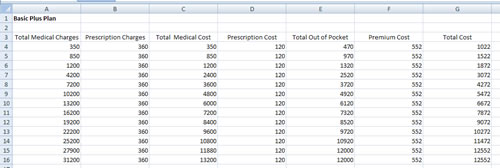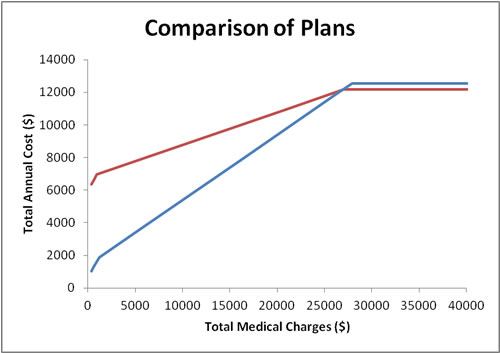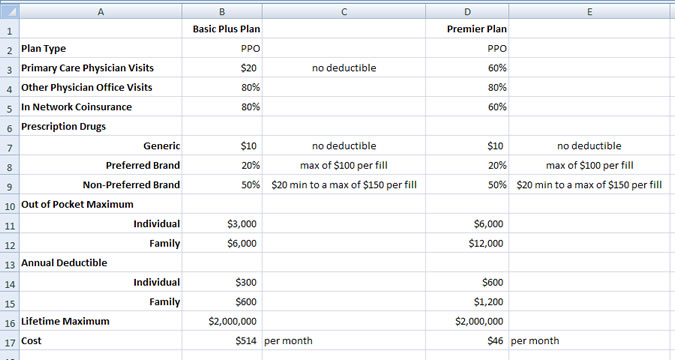I just finished giving this presentation at the AMATYC Conference in Austin, TX. In this 17 minute video, I show how to use tables to recognize the objective function for optimization problems in calculus. I do a number of traditional problems as well as examples on economic order quantity and economic lot size from Business Calculus.
Medical Insurance Project – The Video
Last week I gave a presentation on the Medical Insurance Project at the Fall 2011 ArizMATYC Conference at Estrella Mountain College. This video summarizes the posts I have been making on this project and is a good introduction to the project.
The Medical Insurance Project now has a web page with all of the resources for it in one place. You can click on the link above or access it the the Projects page on the menu at the top of this page. In the notes for this project there is a link to an example of a technical memo for this project. You’ll need to contact me (dave at symbol pblpathways.com) to be able to access this PDF since the file is password protected. My next conference presentation will be at the AMATYC Conference in Austin, Texas. I’ll be presenting on “A Different Strategy for Solving Optimization Problems in Calculus” on Thursday, November 10 from 11:20AM to 12:10PM. Hope to see you there! If you are not able to make it, I’ll post a Flash video of the session immediately afterward.
Medical Insurance Project – Graph the Total Annual Cost
In the last two posts, I described the first steps in modeling the total annual cost as a function of the total medical charges. In the post Medical Insurance Project, I described the basic idea behind the project and how students can collect and organize information on health insurance plans. In the post Medical Insurance Project – Calculate the Total Annual Cost, I described how students create table of values including several total medical charges and the corresponding cost.
Once the students have an appropriate table, they need to graph the data.

In the next technology assignment, student learn how to make a line graph of the total medical charges versus the total annual charges.
Technology Assignment: Graph the Total Annual Cost DOC | PDF
Upon completing this assignment, students will have a graph for each health insurance plan like the ones below.

To compare these graphs, it is convenient to have them on the same graph. In the next technology assignment, students put these two graphs together and find the piecewise linear functions corresponding to each health plan.
Technology Assignment: Find Piecewise Linear Models DOC | PDF
With the graphs together, it is much easier to compare the total costs.

Once students have put these graphs together, hopefully they will make the next logical step which is to find the point of intersection using the piecewise functions.
If the students get to this point successfully, they are over the major hurdles of this project. Next they need to document their solution strategy. I’ll describe the document they turn in for this project in my next blog post.
Medical Insurance Project – Calculate the Total Annual Cost
In an earlier post, I discussed how to have students collect information to model two insurance plans. The second step in modeling the total cost in the Medical Insurance Project is to get the students to create a table of annual medical charges and the corresponding total annual cost using the information they have gathered on their two plans. Using Excel with formulas and fills, they complete a table for each plan.
For 17 and 18 year old students, this is a daunting task. Not only are they struggling with using Excel, they are also struggling with the terminology. In the technology assignment handout, I take great pains to spell out exactly how to use Excel to create the table.
Technology Assignment: Calculate the Total Annual Cost DOC | PDF
As you can see, each step is carefully outlined. You would think that it would be a very simple task for students to create the table for each plan.
Oh how wrong I was about that! Students focus on the steps of using Excel and completely shut down thinking about where the numbers come from. Here are a few of the glaring errors I saw the first time I used this assignment.
- Students do not understand the difference between a medical charge and the cost they pay. Often I found the copay in the medical charges column and vice versa. In an aha moment, I realized that most of them had never seen a bill from a dentist or hospital or received a statement from their insurance company…their parents always got these!
- On the first page of the handout, it describes the assumptions for the table…two office visits, one specialist visit, and one generic prescription. Most student glossed right over the bulleted list and the statment that in the handout I would assume the office visits incur a charge of $100 each, the specialist visits incurs a charge of $150, and the generic prescription incurs a charge of $30 per month.
- There is a lot of confusion over the fact that one must pay the deductible before the charges are split with the insurance company. And once the coinsurance kicks in, they pay a percentage of all charges beyond the deductible and any charges for the visits. While this is not exactly true with all plans (in some you pay the deductible before the copays kick in on the visits), almost every plan my students chose worked that way.
- Some companies report their out of pocket maximum including the deductible and others report it without the deductible. For instance, Blue Cross / Blue Shield reported a deductible of $10000 on one plan with a $4000 out of pocket maximum. This confused students greatly until they noticed that the max did not include the deduictible. In effect, the most that a person might pay in a year under the plan was $10,000 + $4000.
- Students assumed that their first plan was like the Basic Plus Plan (coinsurrance but no copays for visits) and their second plan was like the Premier Plan (copays and coinsurance for visits). In actuality, almost every student chose plans with copays for visits (at least for the first three visits). I had to focus them on the Premier Plan so that they could fill out the tables for both plans.
After giving this assignment for the first time, I had to clean up the carnage so that they could continue working on the project successfully. I created another handout for them on the specific entries in the Premier Plan.
Handout: Deconstructing the Premier Plan DOC | PDF
In this handout I tried to link the formulas in the cells with the assumptions in the plan. Using this, they could modify the formulas to fit their own plans. It is not uncommon that an assignment does not work as anticipated. Sometimes it is just too much too handle in one assignment or your assumptions about your students is way off base. For this assignment, my students had no idea how insurance worked so assuming they could track the numbers through the handout easily was doomed. However, next semester this might work just fine for a group of older, more experienced, students.
Even after I had posted the Deconstructing the Premier Plan Handout, there were a few stragglers still fighting with their Excel spreadsheets. I decided to make a short video on putting together the table of values for total annual cost as a function fo the total medical charges.
Video Constructing the Table for an Insurance Plan
Next semester I plan to put together a short worksheet which the students can complete in class and a corresponding video for online students. This worksheet will give them three different charges (one from each of the three regions on the model) and ask them to caclulate the corresponding charge by hand. This way they will have some familiarity with the concepts and numbers before they start putting the formulas into Excel. I’ll post that worksheet once it is complete.
Medical Insurance Project
In a previous post (Modeling Health Insurance – Project Under Development), I described a choice I had to make regarding health insurance during the summer. In short, I needed to choose between a high premium/low deductible plan and a low premium / high deductible for my family. The analysis I completed on the two plans led me to a new project for College Algebra students.
To present the components of the project, let me explain my thought process in developing the project. The goal of the project is to have students develop models for two medical insurance plans of their choosing and to compare them. The models should give the total annual cost of each plan to the insured as the total medical charges increase. With these models they construct a graph to compare the plans like the one below.
Based on the graph, students can make a choice of the two insurance plans based on their own lives. As a template, I lead them through a potential solution using the information from my two health plans, the Basic Plus Plan and the Premier Plan. They will need to follow the same strategy with two plans of their own choosing.
This means the first task they need to accomplish is selecting two health plans. The technology assignment
Technology Assignment : Collect and Organize Data DOC | PDF
is customized to their unique data (state, age, dependents). This accomplishes one of my requirements of projects. Each student does a unique project based on the theme of comparing health plans.
Once they have this information in hand, they use Excel to document their plan. The primary goal of using Excel in this assignment is to get them familiar with the interface and to demonstrate how to format cells. Later assignments utilize Excel’s capabilities more fully.
When I grade the assignment, I make sure that they have at least given me the most basic information about their plans such as copays, coinsurance, deductibles and out of pocket maximums.
I used this assignments this semester and students had little trouble completing it. There were many comments in class about why some plans are cheaper than others. I was surprised at how many students were completely ignorant about how insurance works. I guess I should not be too surprised since my classes are mainly 17 to 21 year olds with a handful of older students. Opening their eyes to the important issues and terms regarding healthcare was very satisfying.
In my next blog post I’ll talk about the second technology assignment I give students. In this assignment they make a table of increasing medical charges and the corresponding costs to the insured.


